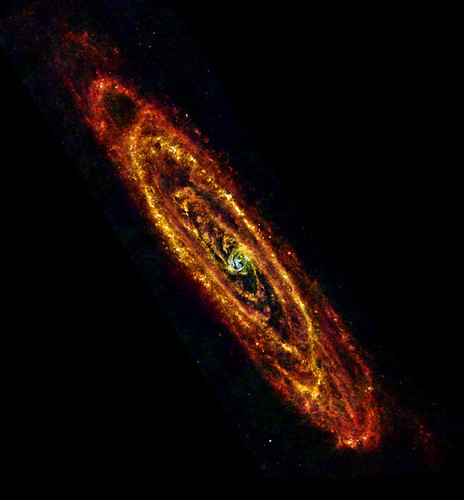Andromeda in the Infrared
- By Maggie Masetti
- February 11, 2013
- Comments Off on Andromeda in the Infrared
Check out this gorgeous new image of the Andromeda Galaxy taken by the European Space Agency’s Herschel space observatory in the far-infrared. This new view shows cool lanes of forming stars in fine detail.
The news release says,
Sensitive to the far-infrared light from cool dust mixed in with gas, Herschel seeks out clouds of gas where stars are born. The new image reveals some of the very coldest dust in the galaxy – only a few tens of degrees above absolute zero – colored red in this image.
By comparison, warmer regions such as the densely populated central bulge, home to older stars, take on a blue appearance.
Intricate structure is present throughout the 200 000 light-year-wide galaxy with star-formation zones organized in spiral arms and at least five concentric rings, interspersed with dark gaps where star formation is absent.
Host to several hundred billion stars, this new image of Andromeda clearly shows that many more stars will soon spark into existence.
As you know, if you follow this blog, at NASA Goddard we’re heavily involved with building the infrared James Webb Space Telescope, which, like Herschel will sit out past the Moon, a million miles away at the second Lagrange point.
We often get questions on the differences between Herschel and Webb. While Webb is much larger and will see near-infrared in addition to mid-infrared, the science they will do is complementary. Webb will be a 6.5m telescope sensitive from gold-colored visible light to the mid-infrared, at wavelengths ranging from 0.6 micrometers to 28.5 micrometers. Herschel is a 3.5m telescope sensitive in the far-infrared from 55 to 670 micrometers wavelength. By working at longer wavelengths, Herschel can see colder objects, such as the earliest stages of star formation in dark clouds and emission from molecules such as water. Webb will view more energetic phenomena including forming proto-stars and very distant galaxies. Getting data with both telescopes on the same objects will build a more complete picture of the astrophysical processes.
This is one of the great things about infrared astronomy… depending on the wavelength of light we’re observing, we can learn different things. Near infrared light allows us to peer inside the dust. Mid-infrared light (that JWST’s Mid-Infrared Instrument will detect) allows us to look AT the dust. This is because when we observe in the mid-infrared, we are seeing the dust itself glow. Check out IPAC’s site for a great to learn even more about the way infrared light works depending on wavelength!
Phil Plait also has a great blog about the Herschel Andromeda image and other observations of this spiral galaxy.



